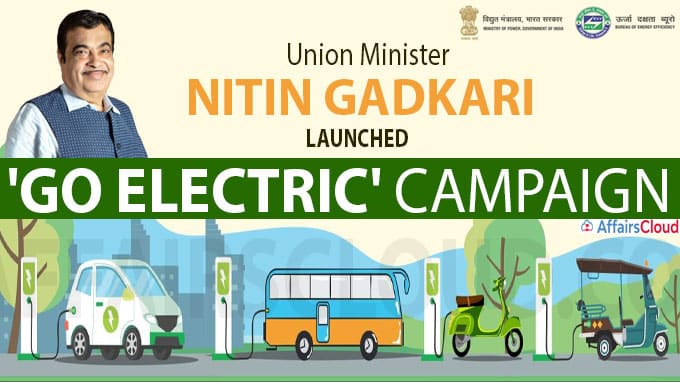
GO ELECTRIC CAMPAIGN
WHY IN NEWS?
- The central government has launched the “Go Electric” Campaign to spread awareness on the benefits of e-mobility and EV Charging Infrastructure as well as electric cooking in India.
About the Campaign:
Features:
- To push the country towards 100% e-mobility and clean and safe e-cooking.
- To create awareness at PAN-India level and reduce the import dependence of the country.
- To move ahead on the path of a low carbon economy, thereby saving the country and the planet from the adverse impact of climate change.
Implementation:
- Bureau of Energy Efficiency (BEE), under the aegis of the Ministry of Power has been mandated to undertake an awareness drive for promoting public charging, e-mobility & its ecosystem.
E-mobility:
About:
- E-mobility moves away from existing carbon-emitting fossil fuels to using energy from electrical power sources (e.g. the National Grid) through external charging capability.
- Currently, India is using 94 million tonnes of oil and petroleum products for transportation only which is expected to double by 2030.
- For fossil fuels, India currently has an import bill of Rs. 8 lakh Crore.
- It encompasses the use of fully electric, conventional hybrid, plug-in hybrid as well as hydrogen-fuelled vehicles.
- The government of India has undertaken multiple initiatives to promote manufacturing and adoption of electric vehicles (EV) in India. One such initiative is ‘Faster Adoption and Manufacturing of (Hybrid &) Electric Vehicles in India (FAME-India)’ Scheme.
Electric Fuel as an Alternative Fuel:
- Electric fuel is a major alternative for fossil fuels.
- When compared to conventional fuels, the electric fuel has low cost, reduced emissions and it is also indigenous.
- Electrification of public transport is not only economical but also eco friendly.
- The usage of even 10,000 electric vehicles in Delhi can alone save Rs. 30 crore per month.
Green Hydrogen:
- Green hydrogen in the commercial vehicle could be a game-changer move which would help in eliminating the crude requirement and imports in all possible ways.
- Green hydrogen is produced using renewable energy and electrolysis to split water. It is distinct from:
- Grey hydrogen, which is produced from methane and releases greenhouse gases into the atmosphere.
- Blue hydrogen, which captures those emissions and stores them underground to prevent them causing climate change.
- Also, for heavy vehicles like buses, the ideal solution is Green Hydrogen.
- The use of green energy generated from agriculture waste and biomass will benefit the farmers across the country.
- The Ministry of New & Renewable Energy can produce the green hydrogen at cheap costs possible in India because of low solar prices.
Electric Cooking:
- The shift to induction cooking will bring the government closer to delivering on its promise to improve energy access.
- Theoretically, if electric cooktops are adopted, universal electrification could translate into universal clean cooking as well.
- An advantage of the electricity-based solution is that it can make use of solar power in both urban and rural areas
Bureau of Energy Efficiency
- The Government of India set up the Bureau of Energy Efficiency (BEE) in March 2002 under the provisions of the Energy Conservation Act, 2001.
- It assists in developing policies and strategies with the primary objective of reducing energy intensity of the Indian economy.
- Major Programmes: State Energy Efficiency Index, Perform Achieve and Trade (PAT) scheme, The Standards & Labeling Programme, Energy Conservation Building Code.
